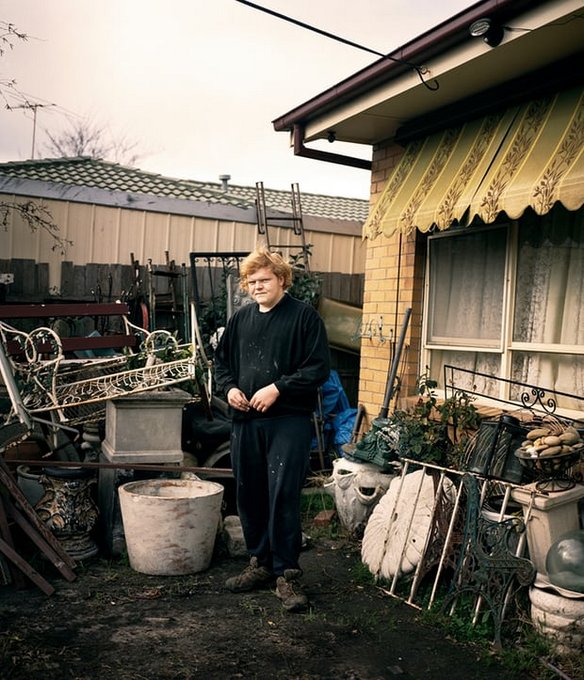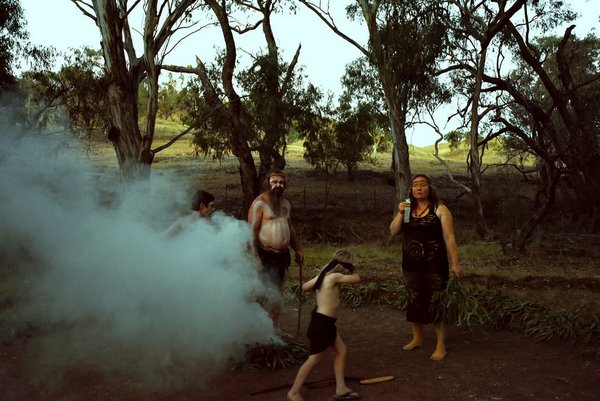James Bugg, a young Melbourne photography school graduate, has won the $50,000 Moran Contemporary Photographic Prize for his image Zach. But not everyone is happy!

The portrait shows Zach, a young man who lives in Frankston North – a working class suburb in south-east Melbourne.
The photo is part of a series captured for James’ graduation project from Melbourne’s Photography Studies College (PSC), which documents disadvantaged people from ‘The Pines’ neighbourhood.
‘I loved James Bugg’s authentic portrait of Zach from the outset,’ said judge Cheryl Newman, a British curator. ‘It is fresh, surprising and beautifully articulates life on the fringes of Australian society. In his hands the lens does not exploit his subject.’
James, 22, said he grew up 15 minutes from The Pines, but had a vastly different upbringing from those living there. He saw Zach working on a car in the driveway, and captured just a few pictures of him.
‘I positioned him there and asked him to look towards me,’ James said. ‘I took two or three frames and that was the one that felt right. I’m shooting on film so I only ever take a few frames of each person.’
Another judge, Jon Jones, a UK photo editor, said the photo ‘offers a glimpse of Australian society rarely visible’.
‘Zach’s direct gaze and awkward stance, surrounded by the discarded pots and garden ornaments that speak of a different time,’ he said.

The other judge was Australian photographer, Raphaela Rosella.
The contest asked photographers to interpret ‘contemporary life in Australia’ with an emphasis on day-to-day life.
Isabella Moore’s The Significance of Ceremony, and Matthew Abbott’s Wrestlers Cooling Off were highly commended.

Commenters critique the critics
It’s practically impossibly to award Australia’s richest photo prize without some online criticism, but The Guardian‘s comment section was dripping with it.
Here’s a sample of what’s being written:
‘All the finalists of this prize really just reflect how little photography has progressed in Australia. The winner is a sub-par carbon copy of what “contemporary documentary” photography students have been producing, since the wave of Alec Soth’s moody portraits influenced anyone with a 6×7 film camera, and a roll of Portra 400, to find the first odd looking person fixing their car in a low socio-economic neighbourhood. I do not find this image challenging, or new by any means, and it really just looks like it follows the same formulated structure you see being produced in and disseminated across the internet and contemporary photography publications. Still clearly one of the better images out of the finalist’s selection – congrats to the young fella. Again, just a bit of a disappointment over all.’
‘In many ways I have to agree with you,’ a reader responded to the above comment. ‘Margaret Bourke-White, Dorethea Lange, Walker Evans were producing more powerful images on a similar theme 90 years ago. And your comment about the irony of posing is on the money and suggests Cartier-Bresson’s images of spontaneous life wouldn’t make the grade.’
‘Another pointless prize that from this twaddle appears to have been judged through use of a blindfold and a set of darts. Result: a lacklustre image if ever there were one.’
‘I don’t understand these prizes for single photos, as the winner never stands up to examination and there have always been hundreds of similar done before. It would be much better to give prizes to a body of work or a particular project where the photos have a context other than being some sort of porn of one sort or another.’
While a negative comment or two is understandable, the number of criticisms aimed toward the judges’ decision-making suggests a divide between contemporary ‘photography experts’ and academics – and everyone else.
It’s not the first time the quality of contemporary photo judging in Australia has been slammed. The issue reared its head far more dramatically last year when Dr Shaune Lakin controversially awarded the $20,000 Olive Cotton Award for Photographic Portraiture to Justine Varga’s print ‘portrait’. Then there was Ken Duncan’s damning critique of ‘photo illustrations’ posing as photographs in the 2017 APPAs.
Looks like the Post-Modern straight-jacket is finally wrapping itself around the practice of picture-taking.





Be First to Comment